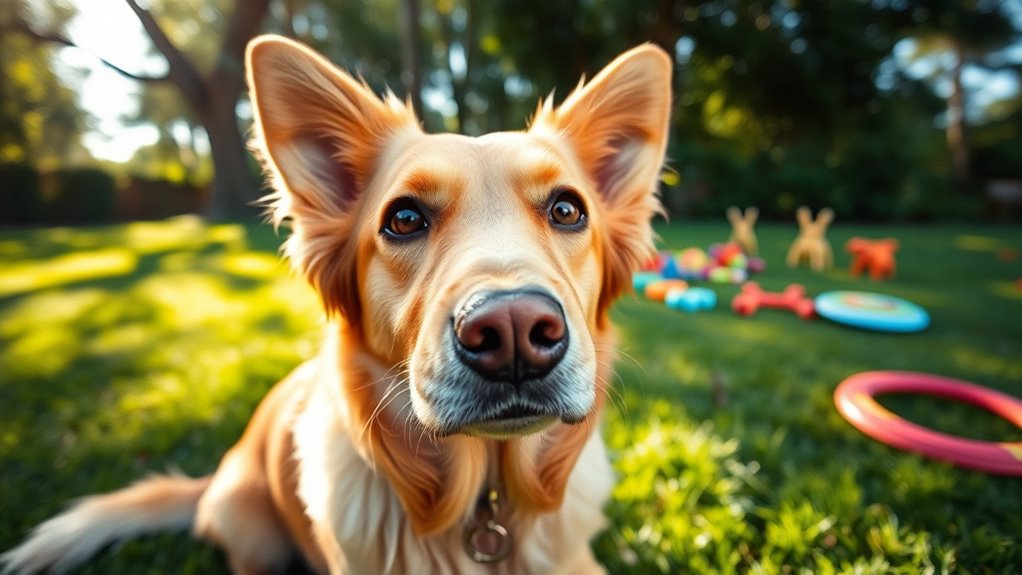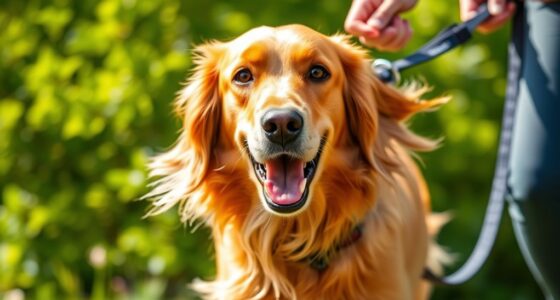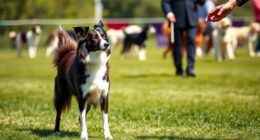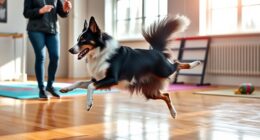Dogs think through a combination of their brain structure, senses, and past experiences. Their cerebral cortex helps with decision-making, while the limbic system manages emotions. They rely heavily on smell, sight, and sound to interpret signals from their environment and you. Learning and memory are influenced by repetition and positive reinforcement, which strengthen their understanding. By understanding these processes, you can better communicate and connect with your dog—keep going to learn more about their amazing cognition.
Key Takeaways
- Dogs process information through sensory pathways, primarily relying on smell, sight, and sound for understanding their environment.
- Their brain structures, including the limbic system and cerebral cortex, support emotions, social cognition, and decision-making.
- Dogs learn via associative and social learning, with repetition and positive reinforcement strengthening memory and behaviors.
- Canine cognition is influenced by genetics, environment, and social experiences, shaping their responses and problem-solving abilities.
- Clear cues and understanding sensory sensitivities improve communication, training, and adaptability in different environments.
The Basics of Canine Brain Structure and Function
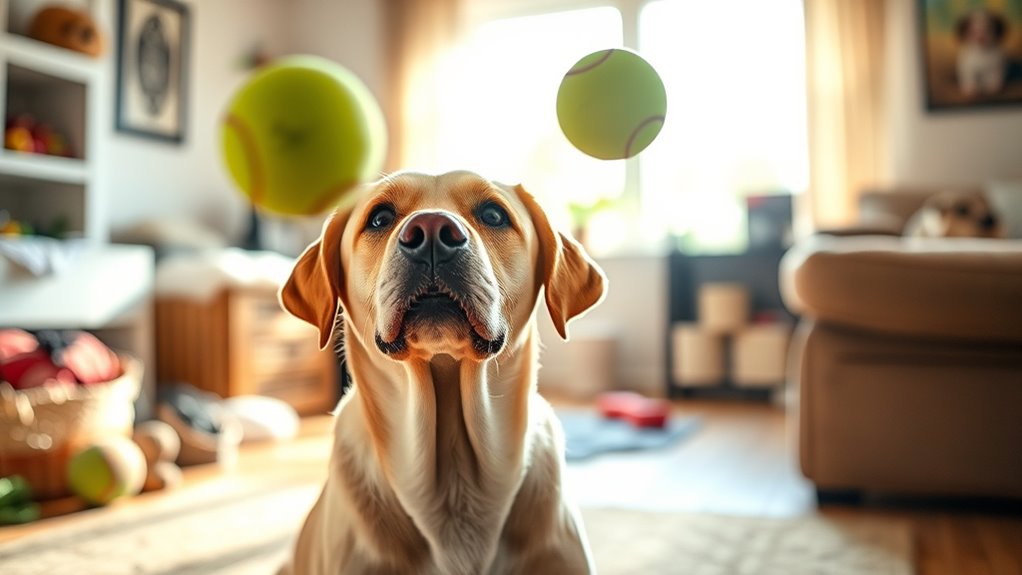
Understanding how dogs think begins with examining their brain structure and function. Your dog’s brain consists of several key brain regions that handle different tasks, such as processing emotions, learning, and memory. These regions connect through complex neural pathways, allowing information to flow efficiently. The cerebral cortex, for example, supports decision-making and problem-solving, while the limbic system governs emotions. These neural pathways facilitate quick responses and learning from experiences. Unlike humans, dogs have a less developed prefrontal cortex, which limits some higher-level thinking. However, their brain’s organization enables impressive social intelligence and adaptability. Additionally, the vetted products for effective training and enrichment can help stimulate these brain regions and promote mental agility. Understanding how these brain regions and neural pathways work together is also crucial for appreciating the canine social structure, which plays a vital role in their cognition and behavior. Recent studies in canine cognition reveal that their neural architecture is highly specialized for social interaction and communication, highlighting the importance of social learning in their development. An awareness of these brain structures can also help owners better interpret their dogs’ signals and behaviors. By understanding how these brain regions and neural pathways work together, you gain insight into your dog’s behaviors and thought processes.
How Dogs Perceive Their Environment

Dogs perceive their environment through a combination of highly developed senses that allow them to interpret the world around them quickly and effectively. Your dog uses smell, sight, sound, touch, and taste to gather information, forming a complex understanding of its surroundings. This sensory input influences how your dog navigates social dynamics and responds emotionally, highlighting its canine emotional intelligence. Recognizing these perceptions helps you better understand your dog’s behavior and communication. The table below illustrates common environmental cues and your dog’s responses:
| Environmental Cues | Dog’s Response |
|---|---|
| Scent trails | Tracks and investigates scent marks |
| Sudden loud noises | Displays alertness or fear |
| Other dogs or animals in view | Shows social interest or caution |
| New objects or surroundings | Explores cautiously or curiously |
| Changes in human behavior | Reads emotional cues, reacts accordingly |
A deeper understanding of sensory perception can help you interpret your dog’s reactions more accurately. Additionally, dogs are capable of associative learning, which means they can connect specific stimuli with outcomes based on past experiences, further shaping their responses. Furthermore, their ability to detect subtle environmental changes enhances their awareness and responsiveness in various situations, aligning with their high cultural intelligence compared to other animals.
Learning Processes and Memory in Dogs

Your dog’s ability to navigate its environment relies heavily on how it learns and remembers. Dogs have remarkable dog memory, allowing them to recall experiences and adapt accordingly. They use different learning styles, such as associative learning and social learning, to acquire new skills. Understanding these processes helps you train effectively and strengthen your bond. Resources and tools such as consistent training methods can significantly enhance your dog’s ability to retain information. Additionally, air purifier technology can improve indoor air quality, which may positively influence your dog’s respiratory health and overall well-being. Recognizing how learning processes operate in dogs enables owners to tailor training techniques for better results. For example, the way dogs form associations between actions and outcomes is fundamental to effective training. The role of repetition in reinforcing memory is well-documented, as consistent practice helps solidify learned behaviors. Differences in learning styles among breeds highlight the importance of adapting training techniques to individual dogs. How positive reinforcement enhances learning is a key principle that encourages dogs to repeat desired behaviors. The importance of consistency for long-term memory cannot be overstated, as it ensures that dogs retain what they have learned over time. Moreover, understanding canine cognition can help owners interpret their dog’s responses more accurately, leading to improved communication.
The Role of Senses in Canine Cognition

Your dog’s sense of smell is their most powerful tool for understanding the world around them. They also rely heavily on visual and auditory cues to interpret their environment and communicate. Recognizing how these senses work together can give you deeper insight into canine cognition. Understanding sensory processing and the use of soundscapes can further enhance our comprehension of how dogs perceive and respond to their surroundings. Additionally, research shows that dogs process sensory information in a way that reflects their sensory specialization, allowing them to adapt quickly to new stimuli and environments. Awareness of their sensory integration can help us better interpret their reactions and behaviors in various contexts.
Smell as Primary Sense
Have you ever wondered how dogs interpret their world? Their primary sense is smell, which surpasses sight and sound in importance. Dogs use scent communication to relay information about each other and their environment. Olfactory navigation helps them explore and understand their surroundings effortlessly. Their noses contain millions of scent receptors, enabling them to detect even trace amounts of odors. Dogs rely heavily on smell to find food, locate members of their pack, and identify threats. This sense shapes their behavior and cognition profoundly. Creating a sensory environment can enhance their ability to process scents and learn from their surroundings. Additionally, research into canine cognition reveals how their sensory processing influences their learning and decision-making processes.
Visual and Auditory Cues
Ever wondered how dogs interpret the world around them through their senses? Dogs rely heavily on visual and auditory cues to understand their environment and communicate. They read body language quickly, noticing posture, tail position, and facial expressions to gauge mood and intent. Vocal signals, like barking, whining, or growling, also play a pivotal role, conveying excitement, warning, or submission. Dogs are especially sensitive to subtle changes in these cues, enabling them to respond appropriately. When you use clear body language and consistent vocal signals, your dog better understands what you want. Recognizing how dogs perceive visual and auditory cues helps you strengthen your bond and communicate more effectively. By paying attention to these signals, you can better interpret your dog’s thoughts and feelings. Additionally, understanding the performance metrics of your dog’s environment, like noise levels and visual stimuli, can influence how well they respond to cues. Being aware of a dog’s sensory priorities can further enhance training and daily interactions. Moreover, understanding the sensory processing capabilities of dogs can help you tailor training and communication methods to suit their natural perceptions. Being mindful of their visual and auditory sensitivities allows you to create a calmer and more responsive environment for your dog. Incorporating positive reinforcement techniques aligned with their sensory strengths can also improve training outcomes and deepen your connection.
Factors Influencing Canine Behavior and Decision-Making

Several factors shape how dogs behave and make decisions, with their environment, experiences, and genetics playing key roles. You should consider genetic predispositions that influence instincts like herding or guarding, which can affect behavior naturally. Social influences matter too; a dog’s interactions with humans, other animals, and its pack shape its responses and learning. Environmental factors, such as living conditions and training methods, also impact decision-making. Stress, noise, and routine can alter a dog’s behavior considerably. Additionally, understanding a dog’s toilet habits can provide insights into its health and well-being, indirectly influencing behavior patterns. Recognizing how environmental stimuli affect a dog can help owners create a positive and consistent routine that supports healthy cognition and learning. For example, exposure to various dog breeds can influence socialization and adaptability. Moreover, understanding the role of payment processing can be essential for pet businesses or services that operate online, ensuring smooth transactions to support pet care needs.
Practical Ways to Enhance Learning and Communication With Dogs

To improve how your dog learns and communicates, focus on reinforcing positive behaviors consistently. Using clear, simple cues helps your dog understand what you expect. These strategies build trust and make training more effective.
Reinforce Positive Behaviors
Reinforcing positive behaviors is essential for effective communication and training with your dog. When you reward good actions, you encourage them to repeat these behaviors. Using reward systems like treats or praise helps your dog associate specific actions with positive outcomes. Incorporate clicker training to mark behaviors precisely, making learning clearer for your dog. Consistency is key—always reward the same good behaviors to build understanding. Remember, timing matters; reward immediately after the behavior. To keep training effective, try these tips:
- Use a clicker to mark specific behaviors
- Offer treats or praise promptly
- Keep rewards varied to maintain interest
- Focus on rewarding effort, not just perfection
- Stay consistent with cues and rewards
This approach strengthens your bond and accelerates learning.
Use Clear Cues
Using clear cues is fundamental to effective communication with your dog, as it helps them understand exactly what you want. When you use consistent commands and gestures, your dog learns faster, aiding in puppy socialization and canine problem solving. Clear cues reduce confusion, build trust, and create a stronger bond. Imagine your dog confidently responding to a simple “sit” or “stay,” knowing exactly what’s expected. To evoke emotion, consider this table:
| Feeling | Your Action |
|---|---|
| Frustration | Use consistent, simple cues |
| Confidence | Reward clear understanding |
| Trust | Be patient and steady |
| Joy | Celebrate their progress |
| Connection | Communicate with love |
Clarity in communication transforms your training into a positive, rewarding experience.
Frequently Asked Questions
Can Dogs Experience Emotions Similar to Humans?
You might wonder if dogs experience emotions like humans, and they definitely do. Puppies show curiosity and excitement, while their canine memory helps them recall positive or negative experiences. When you see a dog wagging its tail or cuddling, it’s expressing feelings of happiness or comfort. Although their emotions aren’t as complex, they genuinely feel joy, fear, or affection, making their emotional world rich and relatable.
How Do Dogs Understand Human Gestures and Language?
You can see that dogs understand human gestures and language through their ability to interpret facial expressions and tone recognition. When you smile or frown, your dog picks up on these cues, helping them respond appropriately. They also notice your tone of voice, understanding whether you’re happy, angry, or excited. This ability allows dogs to connect with you on a deeper level, making communication more effective and strengthening your bond.
Do Dogs Have Problem-Solving Abilities Comparable to Other Animals?
You might wonder if dogs have problem-solving skills comparable to other animals. Research suggests that dog intelligence is impressive; they can solve puzzles and learn new commands. While their problem-solving abilities aren’t as advanced as primates, they excel in tasks relevant to their survival and social needs. So, yes, dogs demonstrate remarkable problem-solving skills that reflect their intelligence, making them adaptable and quick learners in various situations.
How Does a Dog’S Age Affect Its Cognitive Abilities?
As you observe your dog, you’ll notice age impacts its cognitive abilities. During puppy development, your dog is learning rapidly, absorbing new commands and social skills. As it matures, cognitive skills stabilize, but in senior cognition, you might see signs of memory loss or slower problem-solving. Regular mental stimulation helps maintain their cognitive health across all ages, ensuring your dog stays alert and engaged regardless of age.
Can Dogs Learn New Skills or Commands Later in Life?
You might think dogs can’t learn new skills later in life, but that’s a misconception. With consistent training persistence, your dog can definitely master new commands regardless of age. Dogs are capable of lifelong learning, so don’t give up if progress seems slow. Patience, positive reinforcement, and regular practice help older dogs pick up new tricks, proving that learning knows no age limits.
Conclusion
Understanding how dogs think helps you build a stronger bond. For example, if you notice your dog hesitating at a new toy, it’s your cue to introduce it gradually, respecting their perceptions and senses. By considering their brain structure, senses, and learning style, you can improve communication and training. Remember, patience and observation are key, turning everyday interactions into opportunities for your dog’s growth and happiness.

